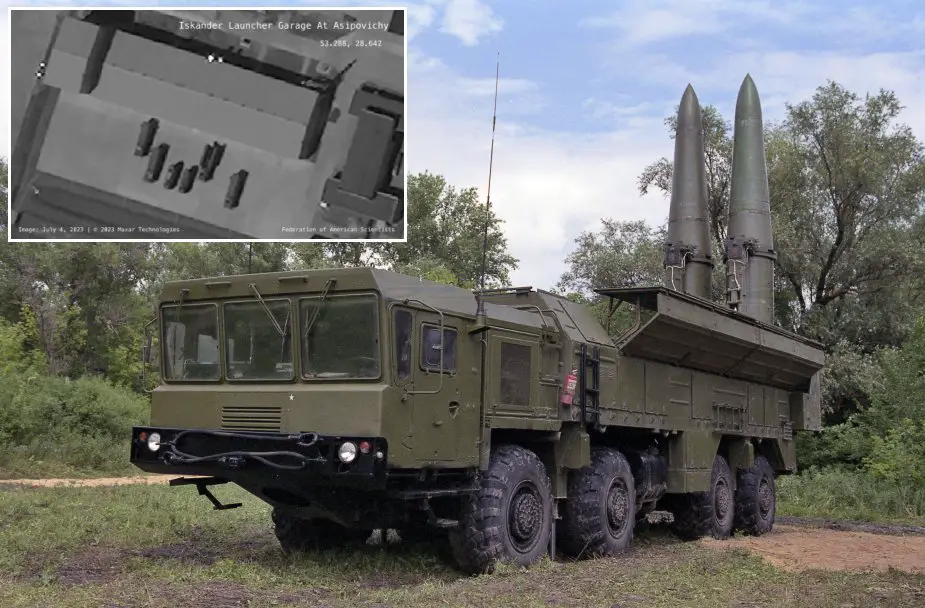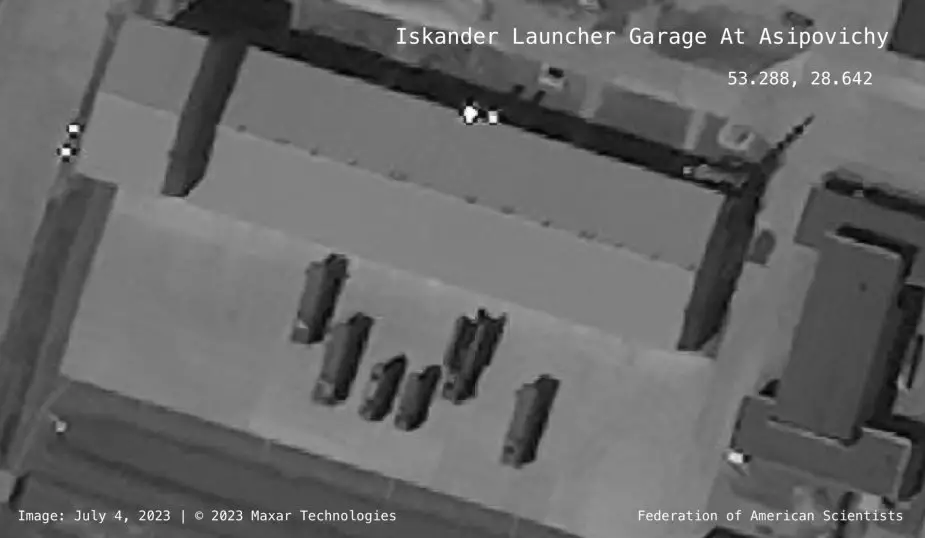- Army
- Conflicts in the world
- Israel - Iran conflict 2025
- Pakistan - India Conflict 2025
- Russia Ukraine War 2022
- Libya conflict day by day
- HAMAS - Israel War 2023
- Operation Serval in Mali French Army
- Sangaris operation Central African Republic
- Sangaris opération militaire République Centreafrique
- Ukraine - Russia conflict
- Syria conflict news
- Defence & Security Industry Technology
- Armies in the world
- Analysis Defense and Security Industry
- Conflicts in the world
- Navy
- Air
Satellite imagery exposes Belarus nuclear-capable Iskander missile launchers
On July 27, 2023, a tweet from Hans Kristensen revealed that satellite imagery had exposed a newly constructed garage facility suspected of housing the Iskander-M missile launchers received from Russia, which are allegedly capable of carrying nuclear warheads.
Follow Army Recognition on Google News at this link

Satellite imagery exposes Belarus nuclear-capable Iskander missile launchers (Picture source: Hans Kristensen and Yandex)
The satellite image captured on July 4, 2023, showed four 13-meter Iskander launchers (and/or transporters) and two smaller support vehicles positioned outside the garage. Notably, one of the launcher's missile storage compartments was observed to be open in the image. This development comes at a time of escalating tensions between Russia, Belarus, and NATO countries like Finland and Poland. In response to Finland joining NATO officially, Russia announced on the same day that it had provided Iskander-M missile systems to Belarus.
In reaction to the presence of Wagner mercenary fighters in Belarus, who are aligned with Russia, Poland has taken steps to relocate some of its military units closer to the Belarusian border. This move is in the context of increasing military activities and geopolitical pressure. In a televised Security Council meeting, Russian President Vladimir Putin issued a strong warning, stating that any aggression against Belarus would be regarded as an attack on Russia and could lead to significant consequences.
The newly constructed garage facility is located at the Asipovichy military base in central Belarus, which is home to the 465th Missile Brigade. Construction of the facility began in October 2022 and was completed in April 2023. The strategic location of the facility is noteworthy, as it is only seven kilometers away from the training ground where the Iskander launchers were initially spotted. Additionally, it is within a 12-kilometer radius of a suspected weapons depot, raising speculation about the possibility of it being used as a temporary nuclear warhead storage site.
Reports suggest that Belarusian President Alexander Lukashenko and Russian President Vladimir Putin had previously discussed plans to enable Belarusian Iskander launchers to launch Russian nuclear-tipped missiles. There were also talks about establishing a nuclear storage facility in Belarus and upgrading some Belarusian military jets, like the Su-24 or Su-25, to carry nuclear bombs. If these plans were to be realized, it would mark a significant development, as it would be the first instance since the Cold War of Russia providing another country with nuclear launch capabilities. This move has raised concerns and drawn comparisons, given Russia's criticism of U.S. nuclear sharing arrangements with NATO allies.
Despite the satellite imagery revelations, there has been no visual confirmation of the alleged plans, and intelligence reports from Western sources have not verified the deployment of nuclear warheads in Belarus by Russia. Currently, it is believed that Russia stores its non-strategic nuclear warheads in centralized facilities within its own territory.

Satellite imagery exposes Belarus nuclear-capable Iskander missile launchers (Picture source Hans Kristensen)
The 9K720 Iskander (NATO reporting name: SS-26 Stone) is a mobile short-range ballistic missile system produced and deployed by the Russian military. It travels at a terminal hypersonic speed of 2,100–2,600 m/s (Mach 6–7) and can reach an altitude of 50 km with a range of up to 500 km. The missile system was designed to replace the OTR-21 Tochka systems in the Russian military.
The Iskander can be equipped with various conventional warheads, including cluster munitions, fuel-air explosive enhanced-blast warheads, high-explosive fragmentation warheads, earth penetrators for bunker busting, electromagnetic pulse devices for anti-radar missions, and nuclear warheads. In September 2017, it was mentioned that there are at least seven types of missiles, including cruise missiles, available for Iskander.
The Iskander-M system is equipped with two solid-propellant single-stage guided missiles, model 9M723K1, each controlled throughout the entire flight path and fitted with an inseparable warhead. The launch platform's mobility makes it difficult to prevent launches.
Targets can be located using satellite imagery, aircraft, conventional intelligence centers, artillery observers, or aerial photos scanned into a computer. The missiles can be re-targeted during flight for engaging mobile targets. Iskander-M's unique feature is the optically guided warhead, which can also be controlled by encrypted radio transmission, including from AWACS or UAV. The missile's onboard computer receives images of the target, locks onto it with its sight, and descends toward it at supersonic speed.
The missile's boost phase thrust vector control (TVC) is achieved by graphite vanes, similar to the layout of V-2 and Scud series tactical ballistic missiles. There are rumors that the missile follows a quasi-ballistic path, performs evasive maneuvers in the terminal phase of flight, and releases decoys to penetrate missile defense systems. The missile remains in the atmosphere and follows a relatively flat trajectory, controlled throughout the whole flight with gas-dynamic and aerodynamic control surfaces, including small fins to reduce its radar signature.
The Russian Iskander-M travels at a hypersonic speed of 2100–2600 m/s (Mach 6–7) and an altitude of 50 km. It weighs 4,615 kg, carries a warhead of 710–800 kg, and has a range of 500 km, achieving a circular error probable (CEP) of 5–7 meters (when coupled with optical homing head; 30–70 m in autonomous application).
The Iskander is designed as a tactical missile system for use in theater-level conflicts. It can use conventional or thermonuclear weapon warheads to engage small and area targets, such as hostile fire weapons, air and anti-missile defenses, command posts, communications nodes, and troops in concentration areas, among others. The missile's area of destruction from a single warhead is claimed to be 25,000 square meters, and its accuracy allows it to hit targets the size of a small window from several tens of kilometers away.
In 2007, a new missile for the system was tested - the R-500 cruise missile - with a range of up to 2,000 km or more. When nuclear armed, the warhead is estimated to have a yield of 5 to 50 kilotonnes of TNT (21 to 209 TJ).


























